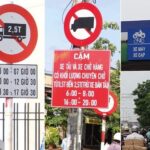Vehicle weight control regulations are a crucial aspect of road transportation, aimed at ensuring traffic safety and protecting infrastructure. Circular 34/2021/TT-BGTVT of the Ministry of Transport details the management and operation of Vehicle Weight Control Stations, replacing Circular 10/2012/TT-BGTVT. This article will analyze the key points of this regulation.
Main Content of Vehicle Weight Control Regulations
Circular 34/2021/TT-BGTVT provides detailed guidance on the management, operation, and inspection of vehicle weight on roads. The objective is to control vehicle weight, ensure traffic safety, and protect road infrastructure.
Scope of Application and Definitions
This regulation applies to all organizations and individuals involved in vehicle weight control activities. Some important concepts are clarified, such as:
- Vehicle Weight Control Station: Includes fixed and mobile stations, equipped with a weight control system, recording equipment, and other supporting devices.
- Road Management Authority: Includes the Directorate for Roads of Vietnam, Regional Road Management Departments, and Departments of Transport.
- Organization assigned to manage and maintain roads: Refers to PPP project enterprises or enterprises assigned by the state to invest in, construct, manage, and operate road projects.
Illustration of a fixed vehicle weight control station
Principles of Weight Control
Vehicle weight control activities must be conducted publicly, objectively, and in accordance with legal regulations. Inspections are carried out through:
- Fixed Vehicle Weight Control Stations: Using fixed weighing systems and recording equipment.
- Mobile Vehicle Weight Control Stations: Using mobile weighing systems.
- Fixed Weighing Equipment Integrated with Toll Stations: Installed at toll stations.
- Portable Scales: Used by authorized functional forces.
- Centralized Monitoring System: Managed and operated by the Directorate for Roads of Vietnam.
- Professional Measures: By functional forces responsible for handling administrative violations.
Requirements for Control Stations
Vehicle weight control stations must meet standards, have weighing equipment that complies with regulations, and be connected to the data management system of the Directorate for Roads of Vietnam.
Illustration of mobile vehicle weight control operation
Operation of Control Stations
The Circular clearly regulates the operation of fixed and mobile control stations, including operating hours, professional requirements for operators, and the use of inspection results for handling violations. Fixed stations operate 24/7, including weekends and holidays. Mobile stations operate according to plans or under emergency directives.
Operating Expenses
Operating expenses of control stations are allocated from road economic operation expenditure or from the management and operation costs of PPP projects.
Reporting Regime
The Circular details the reporting regime for vehicle weight control results, including report names, content, implementing entities, receiving agencies, frequency, and deadlines.
Conclusion
Vehicle weight control regulations under Circular 34/2021/TT-BGTVT have been issued to strengthen vehicle weight management, making a significant contribution to ensuring traffic safety, extending the lifespan of transport infrastructure, and protecting the environment. Strict compliance with these regulations is the responsibility of all organizations and individuals involved in transport activities.

